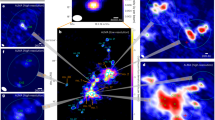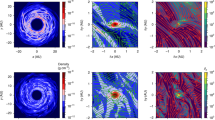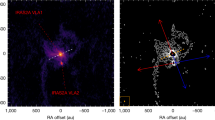Abstract
The initial multiplicity of stellar systems is highly uncertain. A number of mechanisms have been proposed to explain the origin of binary and multiple star systems, including core fragmentation, disk fragmentation and stellar capture1,2,3. Observations show that protostellar and pre-main-sequence multiplicity is higher than the multiplicity found in field stars4,5,6,7, which suggests that dynamical interactions occur early, splitting up multiple systems and modifying the initial stellar separations8,9. Without direct, high-resolution observations of forming systems, however, it is difficult to determine the true initial multiplicity and the dominant binary formation mechanism. Here we report observations of a wide-separation (greater than 1,000 astronomical units) quadruple system composed of a young protostar and three gravitationally bound dense gas condensations. These condensations are the result of fragmentation of dense gas filaments, and each condensation is expected to form a star on a timescale of 40,000 years. We determine that the closest pair will form a bound binary, while the quadruple stellar system itself is bound but unstable on timescales of 500,000 years (comparable to the lifetime of the embedded protostellar phase10). These observations suggest that filament fragmentation on length scales of about 5,000 astronomical units offers a viable pathway to the formation of multiple systems.
This is a preview of subscription content, access via your institution
Access options
Subscribe to this journal
Receive 51 print issues and online access
$199.00 per year
only $3.90 per issue
Buy this article
- Purchase on Springer Link
- Instant access to full article PDF
Prices may be subject to local taxes which are calculated during checkout


Similar content being viewed by others
References
Stamatellos, D. & Whitworth, A. P. The properties of brown dwarfs and low-mass hydrogen-burning stars formed by disc fragmentation. Mon. Not. R. Astron. Soc. 392, 413–427 (2009)
Offner, S. S. R., Kratter, K. M., Matzner, C. D., Krumholz, M. R. & Klein, R. I. The formation of low-mass binary star systems via turbulent fragmentation. Astrophys. J. 725, 1485–1494 (2010)
Moeckel, N. & Bate, M. R. On the evolution of a star cluster and its multiple stellar systems following gas dispersal. Mon. Not. R. Astron. Soc. 404, 721–737 (2010)
Duchêne, G. & Kraus, A. Stellar multiplicity. Annu. Rev. Astron. Astrophys. 51, 269–310 (2013)
Chen, X. et al. SMA observations of class 0 protostars: a high angular resolution survey of protostellar binary systems. Astrophys. J. 768, 110 (2013)
Connelley, M. S., Reipurth, B. & Tokunaga, A. T. The evolution of the multiplicity of embedded protostars. I. Sample properties and binary detections. Astron. J. 135, 2496–2525 (2008)
Connelley, M. S., Reipurth, B. & Tokunaga, A. T. The evolution of the multiplicity of embedded protostars. II. Binary separation distribution and analysis. Astron. J. 135, 2526–2536 (2008)
Reipurth, B. & Mikkola, S. Formation of the widest binary stars from dynamical unfolding of triple systems. Nature 492, 221–224 (2012)
Reipurth, B. et al. Multiplicity in early stellar evolution. Preprint at http://ArXiv.org/abs/1403.1907 (2014)
Evans, N. J., II et al. The Spitzer c2d legacy results: star-formation rates and efficiencies; evolution and lifetimes. Astrophys. J. 181, 321–350 (2009)
Fuller, G. A. et al. Anatomy of the Barnard 5 core. Astrophys. J. 376, 135–149 (1991)
Pineda, J. E. et al. Direct observation of a sharp transition to coherence in dense cores. Astrophys. J. 712, L116–L121 (2010)
Goodman, A. A., Barranco, J. A., Wilner, D. J. & Heyer, M. H. Coherence in dense cores. II. The transition to coherence. Astrophys. J. 504, 223–246 (1998)
Pineda, J. E. et al. Expanded Very Large Array observations of the Barnard 5 star-forming core: embedded filaments revealed. Astrophys. J. 739, L2 (2011)
Perley, R. A., Chandler, C. J., Butler, B. J. & Wrobel, J. M. The expanded Very Large Array: a new telescope for new science. Astrophys. J. 739, L1 (2011)
Lada, C. J. Stellar multiplicity and the initial mass function: most stars are single. Astrophys. J. 640, L63–L66 (2006)
Parker, R. J. & Quanz, S. P. On the frequency of planetary systems around G dwarfs. Mon. Not. R. Astron. Soc. 436, 650–658 (2013)
Tohline, J. E. The origin of binary stars. Annu. Rev. Astron. Astrophys. 40, 349–385 (2002)
Kamazaki, T., Saito, M., Hirano, N. & Kawabe, R. Millimeter-wave interferometric study of the rho Ophiuchi A region. I. Small-scale structures of dust continuum sources. Astrophys. J. 548, 278–287 (2001)
Nakamura, F., Takakuwa, S. & Kawabe, R. Substellar-mass condensations in prestellar cores. Astrophys. J. 758, L25 (2012)
Rosolowsky, E. W., Pineda, J. E., Kauffmann, J. & Goodman, A. A. Structural analysis of molecular clouds: dendrograms. Astrophys. J. 679, 1338–1351 (2008)
Brassfield, E. & Bourke, T. L. Submillimeter Array observations of embedded class I object Barnard 5 IRS1. Bull. Am. Astron. Soc. 43, 340.09 (2011)
Motte, F., Andre, P. & Neri, R. The initial conditions of star formation in the rho Ophiuchi main cloud: wide-field millimeter continuum mapping. Astron. Astrophys. 336, 150–172 (1998)
Alves, J., Lombardi, M. & Lada, C. J. The mass function of dense molecular cores and the origin of the IMF. Astron. Astrophys. 462, L17–L21 (2007)
André, P. et al. From filamentary networks to dense cores in molecular clouds: toward a new paradigm for star formation. Preprint at http://ArXiv.org/abs/1312.6232 (2014)
Matzner, C. D. & McKee, C. F. Efficiencies of low-mass star and star cluster formation. Astrophys. J. 545, 364–378 (2000)
Machida, M. N. & Hosokawa, T. Evolution of protostellar outflow around low-mass protostar. Mon. Not. R. Astron. Soc. 431, 1719–1744 (2013)
Offner, S. S. R. & Arce, H. G. Investigations of protostellar outflow launching and gas entrainment: hydrodynamic simulations and molecular emission. Astrophys. J. 784, 61 (2014)
Kirk, H. et al. Filamentary accretion flows in the embedded Serpens South protocluster. Astrophys. J. 766, 115 (2013)
Peretto, N. et al. Global collapse of molecular clouds as a formation mechanism for the most massive stars. Astron. Astrophys. 555, A112 (2013)
McMullin, J. P., Waters, B., Schiebel, D., Young, W. & Golap, K. in Astronomical Data Analysis Software and Systems XVI (eds Shaw, R. A., Hill, F. & Bell, D. J. ) 127–130 (Astron. Soc. Pacif. Conf. Ser. Vol. 376, 2007)
Holland, W. S. et al. SCUBA-2: the 10,000 pixel bolometer camera on the James Clerk Maxwell Telescope. Mon. Not. R. Astron. Soc. 430, 2513–2533 (2013)
Chapin, E. L. et al. SCUBA-2: iterative map-making with the Sub-Millimetre User Reduction Facility. Mon. Not. R. Astron. Soc. 430, 2545–2573 (2013)
Dempsey, J. T. et al. SCUBA-2: on-sky calibration using submillimetre standard sources. Mon. Not. R. Astron. Soc. 430, 2534–2544 (2013)
Hildebrand, R. H. The determination of cloud masses and dust characteristics from submillimetre thermal emission. Q. J. R. Astron. Soc. 24, 267–282 (1983)
Foster, J. B. et al. Dense cores in Perseus: the influence of stellar content and cluster environment. Astrophys. J. 696, 298–319 (2009)
Enoch, M. L. et al. Bolocam survey for 1.1 mm dust continuum emission in the c2d legacy clouds. I. Perseus. Astrophys. J. 638, 293–313 (2006)
Shu, F. H. Self-similar collapse of isothermal spheres and star formation. Astrophys. J. 214, 488–497 (1977)
Enoch, M. L. et al. The mass distribution and lifetime of prestellar cores in Perseus, Serpens, and Ophiuchus. Astrophys. J. 684, 1240–1259 (2008)
Baumgardt, H., Hut, P. & Heggie, D. C. Long-term evolution of isolated N-body systems. Annu. Rev. Astron. Astrophys. 336, 1069–1081 (2002)
Parker, R. J. & Meyer, M. R. Binaries in the field: fossils of the star formation process? Mon. Not. R. Astron. Soc. 442, 3722–3736 (2014)
Astropy Collaboration et al. Astropy: A community Python package for astronomy. Astron. Astrophys. 558, A33 (2013)
Acknowledgements
We thank K. Todorov for discussions and comments that improved the paper. We acknowledge support from the Swiss National Science Foundation project CRSII2_141880 (J.E.P.), NSF CAREER award AST-0845619 (H.G.A.), NSF grant AST-0908159 (A.A.G.), ERC project PALs 320620 (P.C.) and NASA grant NNX09AB89G (T.L.B.). S.S.R.O. acknowledges support from NASA through Hubble Fellowship grant 51311.01 awarded by the Space Telescope Science Institute, which is operated by the Association of Universities for Research in Astronomy, Inc., for NASA, under contract NAS 5-26555. R.J.P. acknowledges support from the Royal Astronomical Society through a research fellowship. This research made use of astrodendro (http://www.dendrograms.org), Astropy, and APLpy (http://aplpy.github.com). The James Clerk Maxwell Telescope is operated by the Joint Astronomy Centre on behalf of the Science and Technology Facilities Council of the UK, the National Research Council of Canada, and (up to 31 March 2013) the Netherlands Organisation for Scientific Research. Additional funds for the construction of SCUBA-2 were provided by the Canada Foundation for Innovation. The National Radio Astronomy Observatory is a facility of the NSF operated under cooperative agreement by Associated Universities, Inc.
Author information
Authors and Affiliations
Contributions
J.E.P. led the project and reduced the VLA data. J.E.P. and S.S.R.O. wrote the manuscript. R.J.P. conducted the stability analysis of the multiple system. All authors contributed to the VLA proposal, discussed the results and implications, and commented on the manuscript.
Corresponding author
Ethics declarations
Competing interests
The authors declare no competing financial interests.
Extended data figures and tables
Extended Data Figure 1 Dust continuum emission maps of Barnard 5.
a, b, Dust continuum emission observed with SCUBA-2 at 450 µm (a) and 850 µm (b). Contour levels are drawn at 3, 6, 9, 12 and 15× rms, where rms is 0.23 mJy per pixel and 0.026 mJy per pixel in the 450 µm and 850 µm maps, respectively. Emission from dust associated with the protostar B5-IRS1 dominates the field, and it makes it difficult to extract the emission from B5-Cond2 and B5-Cond3. B5-Cond1 is clearly detected in the dust continuum emission. Since the dust continuum emission does show the presence of the filaments in low level emission, we conclude they are real column density features. Filled white circles at bottom left corners show the angular resolution of the observations. Blue- and orange-filled circles show the condensation centres, while the filled stars indicate the protostar (B5-IRS1) location.
Extended Data Figure 2 Mass and virial parameter as a function of radius for condensations.
a, The enclosed condensation mass, derived from NH3(1,1), at different effective radii for each condensation; b, the corresponding virial parameter as a function of effective radius for each condensation. The condensation mass grows rapidly with radius, with a profile similar to one expected for a density distribution of ρ ∝ r−1.5 (dotted line in a) until it is close to the condensation boundary. In comparison, the dashed line shows the expected result in hydrostatic equilibrium (ρ ∝ r−2), which is different to the observed distribution. The virial parameter decreases with radius until it reaches a minimum of ∼1.5, and then it slowly increases until it reaches the condensation boundary. Notice that virial parameters below the horizontal line (α = 2) imply bound condensations. The grey shaded region marks the regime where the effective radius is smaller than the angular resolution of the observations. The circles show the values at the half-mass radius.
PowerPoint slides
Rights and permissions
About this article
Cite this article
Pineda, J., Offner, S., Parker, R. et al. The formation of a quadruple star system with wide separation. Nature 518, 213–215 (2015). https://doi.org/10.1038/nature14166
Received:
Accepted:
Published:
Issue Date:
DOI: https://doi.org/10.1038/nature14166
This article is cited by
-
Observations of high-order multiplicity in a high-mass stellar protocluster
Nature Astronomy (2024)
-
A spectroscopic quadruple as a possible progenitor of sub-Chandrasekhar type Ia supernovae
Nature Astronomy (2022)
-
A protostellar system fed by a streamer of 10,500 au length
Nature Astronomy (2020)
-
Zooming in on Individual Star Formation: Low- and High-Mass Stars
Space Science Reviews (2020)
-
The Origin of the Stellar Mass Distribution and Multiplicity
Space Science Reviews (2020)
Comments
By submitting a comment you agree to abide by our Terms and Community Guidelines. If you find something abusive or that does not comply with our terms or guidelines please flag it as inappropriate.



